pacific
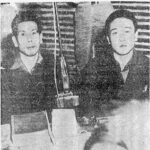
 When a soldier is told to guard an area for his country, he does just that, but on this occasion, this job of “guarding” an area, or an island in this case, was taken to extremes. For a time, the Allies struggled against the Japanese, but by 1945, the tide of World War II had turned decisively against Japan. The Japanese got really nervous as the Americans advanced across the Pacific, drawing ever closer to the Japanese home islands. The American strategists set their sights on Iwo Jima, a small volcanic island about 750 miles south of Tokyo. They saw it as a suitable staging area for an eventual invasion of Japan. Of course, the Japanese were very aware of the threat posed by Iwo Jima landing in American hands. So, they knew they had to garrison the island.
When a soldier is told to guard an area for his country, he does just that, but on this occasion, this job of “guarding” an area, or an island in this case, was taken to extremes. For a time, the Allies struggled against the Japanese, but by 1945, the tide of World War II had turned decisively against Japan. The Japanese got really nervous as the Americans advanced across the Pacific, drawing ever closer to the Japanese home islands. The American strategists set their sights on Iwo Jima, a small volcanic island about 750 miles south of Tokyo. They saw it as a suitable staging area for an eventual invasion of Japan. Of course, the Japanese were very aware of the threat posed by Iwo Jima landing in American hands. So, they knew they had to garrison the island.
Ymakage Kufuku and Matsudo Linsoki were two Japanese machine gunners assigned to the island’s garrison. I can only imagine how they must have felt, knowing that the attack was imminent, and that they could only sit and wait for it. In February of 1945, Iwo Jima was invaded in one of the fiercest and bloodiest battles of the entire Pacific War. The Japanese soldiers fought frantically, almost to the last man. Japanese soldiers were taught that it was more honorable to die that survive, if they lost the war. They were taught that rather than surrender, the honorable thing to do was to commit suicide, so out of a garrison of 21,000 Japanese, nearly 20,000 died before the island was declared secured.
Kufuku and Linsoki were among the few Japanese soldiers who didn’t die in the fighting and didn’t commit suicide. They also believing what their government told them about Americans torturing and killing prisoners, so they were too afraid to surrender. The two men felt like they had no choice but to go underground. They also expected that soon the Japanese would be able to take the island back, so they hid during the day in the multitude of tunnels that were all over the island. They came out at night pilfer food and other necessaries from the American garrison’s supply and trash dumps. It was a tough kind of life, but by doing this, Kufuku and Linsoki managed to survive for a long time in a barren and inhospitable island that was mighty short on both vegetation and game. The Americans weren’t interested in exploring Iwo Jima’s hard landscape, a fact that allowed the two Japanese soldiers to go unnoticed for years.
Finally, on January 6th, 1949, two US Air Force corporals in a Jeep spotted a couple of pedestrians in uniforms that looked to be a few sizes too big. The men were walking alongside a road. The soldiers thought the men were Chinese laborers. The men spoke no English and they didn’t seem to want to talk, but the American airmen just assumed they were hitchhiking to the island’s main base and gave them a lift. They dropped them off in front of the garrison’s headquarters building. That probably left Kufuku and Linsoki a little bit unnerved. Nevertheless, they didn’t want to seem suspicious, so they wandered around the American base for hours, at least until a passing American sergeant realized that they were Japanese and took them in. The men were 
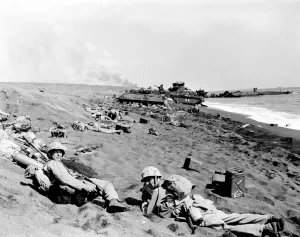 interrogated, and afterward, they took their captors to their hideout. There, to their amazement, the Americans found a cave richly stocked with canned foods, flashlights, batteries, uniforms, boots, shoes, socks, and other goods that the pair had been pilfering over the years. I’m quite sure they recognized some of the items from the base. While the Japanese soldiers did no real harm, their self-imposed secret mission had come to an end.
interrogated, and afterward, they took their captors to their hideout. There, to their amazement, the Americans found a cave richly stocked with canned foods, flashlights, batteries, uniforms, boots, shoes, socks, and other goods that the pair had been pilfering over the years. I’m quite sure they recognized some of the items from the base. While the Japanese soldiers did no real harm, their self-imposed secret mission had come to an end.

 Japan entered World War I as a member of the Allies on August 23, 1914. Assisting the Allies with the war effort was not their reason for doing so, however. Once in, Japan seized the opportunity of Imperial Germany’s distraction with the European War to expand its sphere of influence in China and the Pacific. Because Japan already had a military alliance with Britain, there was minimal fighting as they pushed through to make their territorial gains. Japan was not pressured to enter the war. The Allies had things well in hand, so their motive was obvious. As they swept through, they quickly acquired Germany’s scattered small holdings in the Pacific and on the coast of China. While those holdings were relatively easy to overtake, not all of Germany’s holdings were so easy.
Japan entered World War I as a member of the Allies on August 23, 1914. Assisting the Allies with the war effort was not their reason for doing so, however. Once in, Japan seized the opportunity of Imperial Germany’s distraction with the European War to expand its sphere of influence in China and the Pacific. Because Japan already had a military alliance with Britain, there was minimal fighting as they pushed through to make their territorial gains. Japan was not pressured to enter the war. The Allies had things well in hand, so their motive was obvious. As they swept through, they quickly acquired Germany’s scattered small holdings in the Pacific and on the coast of China. While those holdings were relatively easy to overtake, not all of Germany’s holdings were so easy.
In fact, the other Allies quickly started to realize that Japan’s motives weren’t exactly in everyone’s best interests, and they began to push back hard against Japan’s efforts to dominate China through the Twenty-One Demands of 1915. Japan’s occupation of Siberia against the Bolsheviks failed, as its wartime diplomacy and limited military action produced few results. Then, by the time of the Paris Peace Conference in 1919, Japan was largely frustrated in its ambitions. Nevertheless, Japan had snapped up Germany’s Asian colonies with ease, and even the African colony of Togoland (now Togo and parts of Ghana) fell in less than three weeks. The first real sign of resistance was when German Kamerun (Cameroon) was invaded and lightly contested until 1916. Still, it fell in the end. It seemed that Japan was undefeatable.
Nevertheless, with all the victories, the German colonies in East Africa led by the formidable and undefeated Paul von Lettow-Vorbeck proved to be the exception to the rule. The situation facing von Lettow-Vorbeck and his colonial forces was formidable. Still, von Lettow-Vorbeck knew how to fight, and he refused to back down. When the Japanese came up against von Lettow-Vorbeck, they found themselves heavily outnumbered, and they found themselves with no prospect of reinforcements or much in the way of material support arriving anytime soon.
The fact was that von Lettow-Vorbeck was seeking to tie up British military resources in Africa to relieve some pressure on the European theater. He drew upon his many years of service in Africa to wage a highly effective guerilla war against a much larger enemy. Von Lettow-Vorbeck was probably one of the greatest guerilla warfare strategists of all time…maybe the greatest. Von Lettow-Vorbeck even gained the loyalty of his African soldiers. In those days, it was highly unusual for a commanding officer or any white soldier for that matter, to show any level of respect to the African soldiers. Von Lettow-Vorbeck did, by appointing Black officers and speaking Swahili. The German troops had learned to live off the land and make the most of very little supplies, due to hard lessons drawn from years of colonial warfare in Africa. Those years were filled with atrocities, but they had persevered.
This one small German colonial army tied up the British forces for the duration of the conflict. The British had been plundering food 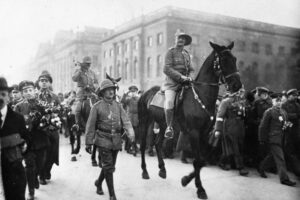 supplies that devastated the local population. Finally, the German army surrendered on November 25, 1918, in Zambia, two weeks after the November 11, 1918 armistice ended hostilities. Of course, Hitler knew a great officer when he saw one, and so after the war, Hitler immediately offered von Lettow-Vorbek a prestigious position in the Third Reich. In what most would consider a complete shock, von Lettow-Vorbeck bluntly refused the offer, using some very “colorful” language, which shall not be repeated here. It was a courageous, but not very wise move, given the circumstances. Nevertheless, his boldness, as well as his loyalty to the German people, paid off. Von Lettow-Vorbeck was simply too popular with the German people to be eliminated by the regime. He lived to be 94.
supplies that devastated the local population. Finally, the German army surrendered on November 25, 1918, in Zambia, two weeks after the November 11, 1918 armistice ended hostilities. Of course, Hitler knew a great officer when he saw one, and so after the war, Hitler immediately offered von Lettow-Vorbek a prestigious position in the Third Reich. In what most would consider a complete shock, von Lettow-Vorbeck bluntly refused the offer, using some very “colorful” language, which shall not be repeated here. It was a courageous, but not very wise move, given the circumstances. Nevertheless, his boldness, as well as his loyalty to the German people, paid off. Von Lettow-Vorbeck was simply too popular with the German people to be eliminated by the regime. He lived to be 94.
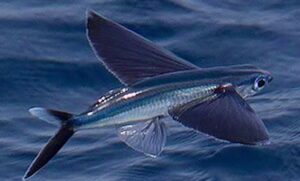 Since I am not a fishing fanatic, and in fact, I find the sport…boring, sorry folks, but I do, I’m sure it seems odd for me to write a fish story. Nevertheless, there was a time when I found a certain fish really fascinating. My husband, Bob Schulenberg and I were on a Caribbean cruise for our 25th anniversary, and we loved walking the upper deck of the ship. We often stood looking over the edge looking for dolphin, but it was not dolphin that really made an impact on us, although we did see dolphin. The fish that really caught our eye was the Flying Fish.
Since I am not a fishing fanatic, and in fact, I find the sport…boring, sorry folks, but I do, I’m sure it seems odd for me to write a fish story. Nevertheless, there was a time when I found a certain fish really fascinating. My husband, Bob Schulenberg and I were on a Caribbean cruise for our 25th anniversary, and we loved walking the upper deck of the ship. We often stood looking over the edge looking for dolphin, but it was not dolphin that really made an impact on us, although we did see dolphin. The fish that really caught our eye was the Flying Fish.
Flying fish, also known as Exocoetid is a marine fish in the order Beloniformes class Actinopterygii, known in simple terms as flying fish or flying cod. They are “ray-finned fish with highly modified pectoral fins.” While they are called Flying Fish, the  name is a bit misleading in that they aren’t capable of powered flight. Their fins can’t act as wings. Instead they propel themselves out of the water at speeds of more than 35 miles an hour. Once in the air, their rigid “wings” allow them to glide for up to 650 feet. The wing-like pectoral fins are primarily for gliding. Then, while swimming, the fish hold the fins flat at their sides. Their streamlined bodies reduce drag when the fish are “flying.” However it works, the Flying Fish is a unique and very interesting thing to see…especially when you had no idea that such a thing existed. Another interesting characteristic of the flying fish is its “unevenly forked tail, which has a top lobe that’s shorter than the bottom lobe.” While the Flying Fish looked small from the deck of the ship, they can actually be up to 18 inches long. Nevertheless, they average Flying Fish is 7 to 12 inches.
name is a bit misleading in that they aren’t capable of powered flight. Their fins can’t act as wings. Instead they propel themselves out of the water at speeds of more than 35 miles an hour. Once in the air, their rigid “wings” allow them to glide for up to 650 feet. The wing-like pectoral fins are primarily for gliding. Then, while swimming, the fish hold the fins flat at their sides. Their streamlined bodies reduce drag when the fish are “flying.” However it works, the Flying Fish is a unique and very interesting thing to see…especially when you had no idea that such a thing existed. Another interesting characteristic of the flying fish is its “unevenly forked tail, which has a top lobe that’s shorter than the bottom lobe.” While the Flying Fish looked small from the deck of the ship, they can actually be up to 18 inches long. Nevertheless, they average Flying Fish is 7 to 12 inches.
Another thing I didn’t know is that there are approximately 40 species of flying fish. They are tropical fish and 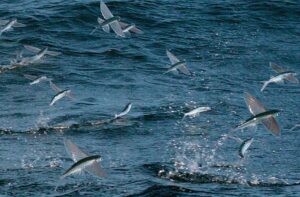 can be seen off both the Atlantic and Pacific coasts of the United States. They are also found in the Atlantic, Pacific, and Indian oceans. most flying fish live in open oceans, but some live on the outskirts of coral reefs.
can be seen off both the Atlantic and Pacific coasts of the United States. They are also found in the Atlantic, Pacific, and Indian oceans. most flying fish live in open oceans, but some live on the outskirts of coral reefs.
I don’t claim to know all the fish in the sea, but I had no idea that such a thing existed. At first we thought they were birds. We couldn’t figure out how these “little birds” could be flying around so far out to sea, then we found out that they were actually fish. I’ll never forget how cool it was to watch them. It was a highlight of the cruise…very strange for a non-fisherman, I know.
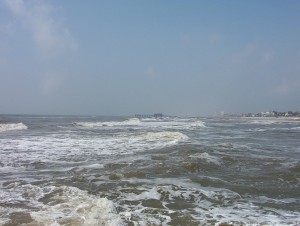 I will never forget the first time I saw the ocean. I can’t tell you the exact spot, unfortunately, but it was along the coast of Maine. Our family had taken a trip to visit my sister, Cheryl Masterson whose husband was stationed in Plattsburgh, New York at the time. While we were there, the whole family took a trip down the east coast. It was amazing. That first ocean view was one of the most awe inspiring views I have ever seen, as I’m sure anyone who has seen the ocean would agree. It is difficult to comprehend such a vast expanse of water, with no visible land on the other side. There are the great lakes too, of course, and they do give a feel of an ocean, but you know they are just lakes, and as quickly as it appeared, that feeling of unbelievable vastness passes. But, the ocean…that view is one that will always have a place in my memory files.
I will never forget the first time I saw the ocean. I can’t tell you the exact spot, unfortunately, but it was along the coast of Maine. Our family had taken a trip to visit my sister, Cheryl Masterson whose husband was stationed in Plattsburgh, New York at the time. While we were there, the whole family took a trip down the east coast. It was amazing. That first ocean view was one of the most awe inspiring views I have ever seen, as I’m sure anyone who has seen the ocean would agree. It is difficult to comprehend such a vast expanse of water, with no visible land on the other side. There are the great lakes too, of course, and they do give a feel of an ocean, but you know they are just lakes, and as quickly as it appeared, that feeling of unbelievable vastness passes. But, the ocean…that view is one that will always have a place in my memory files.
I remember too, that it was in Maine that I hade my first taste of lobster. Oh my gosh…it was  heavenly. Many people say that the experience of eating lobster on the coast probably ruined lobster for me, because it just doesn’t taste the same anywhere else. That may be true, but lobster is still heavenly, and all I can say if that I wish the price for it wasn’t so far out of this world. There are so many experiences that are only enhanced by their natural habitat, and while lobster eating is one of them, I’ll do my best to struggle through it, anytime I get the chance.
heavenly. Many people say that the experience of eating lobster on the coast probably ruined lobster for me, because it just doesn’t taste the same anywhere else. That may be true, but lobster is still heavenly, and all I can say if that I wish the price for it wasn’t so far out of this world. There are so many experiences that are only enhanced by their natural habitat, and while lobster eating is one of them, I’ll do my best to struggle through it, anytime I get the chance.
While my husband, Bob and I have seen the Atlantic and Pacific Oceans, the Caribbean Sea, the Gulf of Mexico, and now, the Gulf of Alaska, and each of those experiences have been awesome, they couldn’t compare to the way I felt at my first ocean view. Obviously I was a younger girl then, and while I was pretty well traveled as a child, there are simply some sights that tower over others in your mind. I wasn’t so young at that first ocean view,  exactly, at 15 years of age, but somehow the view of the ocean made me feel like I was younger and smaller. Its vastness was so much to take in. I wondered what things were on the other side, and how many desert islands were in between this side and that side. I wondered about the shipwrecks there might be from days of pirates and hurricanes, and about the fish that lived in the ocean. All were things I would probably never know about…or would I? Perhaps with a little research, the events of the ocean’s past could open up and I could be privy to the secrets that lie beneath those vast expanses of beautiful blue water too.
exactly, at 15 years of age, but somehow the view of the ocean made me feel like I was younger and smaller. Its vastness was so much to take in. I wondered what things were on the other side, and how many desert islands were in between this side and that side. I wondered about the shipwrecks there might be from days of pirates and hurricanes, and about the fish that lived in the ocean. All were things I would probably never know about…or would I? Perhaps with a little research, the events of the ocean’s past could open up and I could be privy to the secrets that lie beneath those vast expanses of beautiful blue water too.
 Most little kids don’t really like fish much, unless it is in the form of fish sticks, and I don’t think fish sticks existed when my sister, Cheryl and I were little girls. I don’t know why Cheryl wanted to have her picture taken with all these fish, or if my mom just set her there because she would be a good point of reference to show just how many fish there were here, but I do know that it would have been a good thing that the fish were dead already, because if they had been flipping around, Cheryl would have probably been freaking out for sure…I know I would have, but then I was a baby. The fish were Smelt, and there were lots of them.
Most little kids don’t really like fish much, unless it is in the form of fish sticks, and I don’t think fish sticks existed when my sister, Cheryl and I were little girls. I don’t know why Cheryl wanted to have her picture taken with all these fish, or if my mom just set her there because she would be a good point of reference to show just how many fish there were here, but I do know that it would have been a good thing that the fish were dead already, because if they had been flipping around, Cheryl would have probably been freaking out for sure…I know I would have, but then I was a baby. The fish were Smelt, and there were lots of them.
Rainbow Smelt, which are silver-colored fish about 6 to 9 inches long, are not native to Lake Superior, but rather to the Atlantic and Pacific Oceans. Smelt entered the Great Lakes accidentally in 1912 when they escaped from an inland lake in Michigan where they had been stocked as forage fish. After that, they quickly spread throughout Lake Michigan and were finally discovered in Lake Superior in 1946. By that time, Sea Lamprey, which had also invaded Lake Superior, had begun reducing the number of native lake Trout, so there were far less Trout to eat the Smelt and they began to rapidly increase in number. Every year in mid-April, the Smelt head for the streams to lay their eggs. They are light sensitive, so smelting must be done at night. The best place to go smelting is at the mouth of the streams where they enter the Lakes. The rapids make it more difficult for the fish to jump over them into the stream, and so they are in abundance at that place. Smelting was a big deal at the time we were living in Superior, Wisconsin, when Cheryl and I were little girls.
When April came around in 1957, Mom, Dad, Uncle Bill, and Aunt Doris took Cheryl, me, and our cousin, Pam, and went smelting. Of course, the women pretty much just watched the proceedings, while Dad and Uncle Bill gathered up the buckets of fish that would be our haul for the evening. It was a good run, and the amount of fish they took home was amazing. The fish were then cleaned and frozen for lots of good eating down the road. I’ve never been smelting, at least where I actually participated, but I can imagine that it was pretty exciting to see all those fish all at once. usually think of fishing as a lazy day sport, and normally it is, but during a smelting run, it sounds pretty exciting to me!!
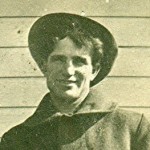 The Great Northern Railway was created in September of 1889. The line was the dream of one man…James Jerome Hill. He was called the Empire Builder, because of his ability to create prosperous business seemingly from nothing. It came to be as a result of the combining of several predecessor railroads in Minnesota and eventually stretched from Lake Superior at Duluth to Minneapolis/St Paul west through North Dakota and Northern Idaho to Washington State at Everett and Seattle. The Great Northern Railway was in operation until 1970 when it merged with the Northern Pacific Railway, the Chicago, Burlington and Quincy Railroad and the Spokane, Portland and Seattle Railway to form the Burlington Northern Railroad. The Burlington Northern Railroad operated until 1996, when it merged with the Atchison, Topeka and Santa Fe Railway to form the Burlington Northern and Santa Fe Railway.
The Great Northern Railway was created in September of 1889. The line was the dream of one man…James Jerome Hill. He was called the Empire Builder, because of his ability to create prosperous business seemingly from nothing. It came to be as a result of the combining of several predecessor railroads in Minnesota and eventually stretched from Lake Superior at Duluth to Minneapolis/St Paul west through North Dakota and Northern Idaho to Washington State at Everett and Seattle. The Great Northern Railway was in operation until 1970 when it merged with the Northern Pacific Railway, the Chicago, Burlington and Quincy Railroad and the Spokane, Portland and Seattle Railway to form the Burlington Northern Railroad. The Burlington Northern Railroad operated until 1996, when it merged with the Atchison, Topeka and Santa Fe Railway to form the Burlington Northern and Santa Fe Railway.
I’m sure you are wondering why I would be telling you this. It’s because this particular railroad played a part in my family’s past. My grandfather (my dad’s dad) worked on the Great Northern Railway. My dad and his siblings had passes to ride the Great Northern Railway for free, as a dependant of an employee. I think it is much of the reason that my whole family loves trains and riding on trains.
Grandpa was a wanderer. He loved to see new places and experience new things. The railroad gave him the ability to do just that…and also kept him away from his family a lot, unfortunately. My grandpa was born 133 years ago today..that seems an impossible number. My grandfather was 77 years older than me. He passed away in 1951, 5 years before I was born. My dad drove back to Wisconsin, making the 1000 mile trip in 17 hours, which was pretty quick back in the 50’s. He did make it to his dad’s side before he passed away on October 19, 1951.
Because he passed away before I was born, I don’t know much about my grandfather. I  have to think though, that there was a bit of a little boy in him that he never outgrew. His smile indicated that he had a great sense of humor, with just a hint of mischievousness. I think that his boyish grin could very well have been the very thing that caught my grandmother’s eye. I think he was always full of boyish charm and mischief, and a need to see what was around the next turn in the road…or in this case, the next curve of the tracks.
have to think though, that there was a bit of a little boy in him that he never outgrew. His smile indicated that he had a great sense of humor, with just a hint of mischievousness. I think that his boyish grin could very well have been the very thing that caught my grandmother’s eye. I think he was always full of boyish charm and mischief, and a need to see what was around the next turn in the road…or in this case, the next curve of the tracks.

